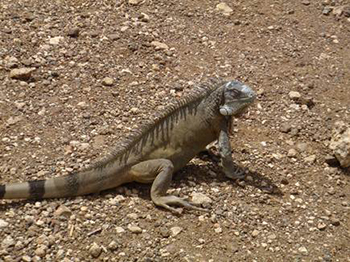Green Iguana

guana iguana
Taxonomy:
Kingdom Animalia
Phylum Chordata
Class Reptilia
Order Squamata
Family Iguanidae
Description:
Full grown iguanas can be anywhere from four to six feet in length. This is including their tail which can be up to half of their body length. The green iguana’s color depends on what area it’s from. They can range anywhere from a bluish color, to multiple shades of green, and even to a lavender. They have a row of spines down their back that helps to protect them from predators. They also are equipped with a long set of claws to help them climb trees (Green).
Habitat:
Iguanas live in tropical rainforests and generally near a water source. They spend most of their time in the forest canopy about 40-50 feet from the ground (Green).
Behavior:
Green iguanas are diurnal which means that they are more active during the day. Iguanas are cold blooded so to stay warm they lay in the sun (Green). Green Iguanas also lay in the sun to synthesize vitamin D3 which is crucial for an iguana’s health. The heat from the sun also activates the bacterium in the iguanas gut to help digest its previous meal. Once the iguana is heated it can move faster and will usually go look for food (Iguana).
Reproductive cycle and family habits:
A female green iguana lays 20-71 eggs once per year. The female will dig multiple burrows but only put her eggs in one to confuse predators. Once the female lays the eggs, she will leave and never return to parent the babies. It takes about two years for the iguanas to grow into mature adults. As adults, green iguanas live alone. As juveniles, the iguanas live in familial groups, where the males protect the females from predators. Iguanas are the only reptile species that do this (Green).
Diet:
Green iguanas are herbivores and eat mostly leaves, flowers, fruit and shoots of about 100 different plants. Juvenile green iguanas sometimes eat the feces of an adult iguana to get the proper microbes to help digest their low quality vegetarian diet (Green).
Ecology:
Green iguanas are valuable to Central and South America as food. They are sometimes called “bamboo chickens” or “chicken of the tree” because they are said to taste like chicken. Green iguanas are also highly popular as pets due to their calmness and bright colors. Unfortunately, this has caused overhunting of the iguanas. Though, laws have been put into affect to help with the overhunting and pet trade, they are not strictly enforced (Green).
Research:
One recent research with green iguanas dealt with finding their sleep and awake patterns. This was tested this by implanting electrodes in multiple places on the iguana. It was found that the iguana has two sleep phases just like birds and mammals. They also found out that green iguanas are polyphasic meaning that they sleep multiple times in a 24-hour period (Ayalaguerrero, 2008.).
Scientists also did a study, affect of bacteria on the oxygen uptake of green iguanas. The iguanas were either injected with saline or bacteria. The oxygen intake of the iguanas that had the bacteria compared to those that got the saline showed no significant difference in oxygen intake. From this, they concluded that iguanas do not increase their internal heat production to fend off bacteria (Malvin, 1979.).
Personal Interest:
I chose the green iguana because I have always been interested in lizards and wanted to know more about them.
References:
Please note that the following references may have either been removed or relocated by the webpage owners since the time this student report was created.
Ayalaguerrero, F., and G. Mexicano. "Sleep and Wakefulness in the Green Iguanid Lizard (Iguana Iguana)☆." Comparative Biochemistry and Physiology – Part A: Molecular & Integrative Physiology 151.3 (2008): 305-12. Print.
"Green Iguana." Home - EcoHealth Alliance – Formerly Known as Wildlife Trust. 2000. Web. 26 May 2011. <http://www.thewildones.org/Animals/iguana.html>.
"Green Iguana." Wikipedia, the Free Encyclopedia. 19 May 2011. Web. 26 May 2011.< http://en.wikipedia.org/wiki/Green_Iguana>.
"Iguana Behaviour | Green-iguana.info." Green Iguana. 2 Jan. 2006. Web. 26 May 2011.< http://green-iguana.info/node/node/2>.
Malvin, M., and M. Kluger. "Oxygen Uptake in Green Iguana (Iguana Iguana) Injected with Bacteria☆." Journal of Thermal Biology 4.2 (1979): 147-48. Print.